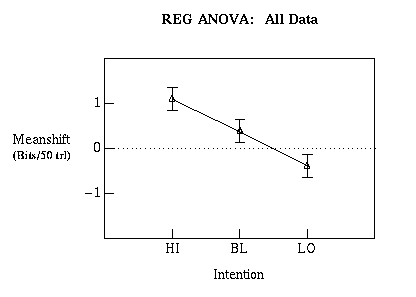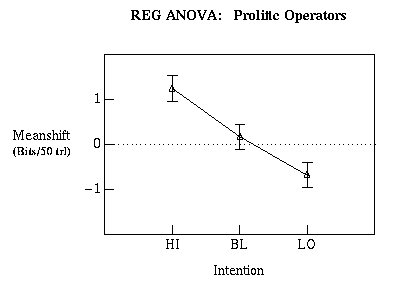Analysis of Variance of REG Experiments:
Operator Intention, Secondary Parameters, Database Structure
R. D. Nelson, Y. H. Dobyns, B. J. Dunne, and R. G. Jahn, Princeton Engineering Anomalies Research, Princeton University, Technical Note, PEAR 91004, Princeton, NJ 08544.
A comprehensive analysis of variance has been applied to a random event generator (REG) database comprising over 5.6 million trials, accumulated in 1262 experimental series performed by 108 individual operators over a period of 12 years. In these experiments, operators attempt to shift the means of output distributions of 200-sample binary combinations drawn from random sources in accordance with prespecified intentions, using a variety of devices and protocols designed to address particular questions. Experimental designs are sufficiently similar to allow all data to be pooled in a multiway analysis of variance to examine the factor of primary interest, operator intention, and its modulation by various secondary parameters, such as individual differences among the operators, the specific device and protocol, operator location, run length, assignment mode, control mode, series order, and feedback.

These analyses confirm the existence of anomalous results with operator intention as the primary correlate, at a p-value of 2.4 x 10E-4 in the full database, and reveal internal structure that is dependent on some of the other parameters. Most striking of these is a significant difference among prolific operators, supporting earlier evidence for individual operator performance signatures.

Results are very similar for a diode-based white noise source and a hardwired, deterministic pseudorandom source, indicating that the effects are not specific to a particular device, but experiments using an algorithmic pseudorandom source do not show a comparable effect. Local and remote operator databases do show similar patterns of interaction with intention, suggesting that the anomalous effects are insensitive to separation between the operator and the device. Of the other factors considered, the feedback mode displays some relevance in prolific operator databases, and series number shows a suggestive pattern across operators. Random vs. volitional instruction, manual vs. automatic trial initiation, and run length differences have no significant influence in the overall concatenations, but are important determinants in some individual operator databases.
The analysis, like the experiments, has been designed to negate various conventional explanations for the deviations from chance expectation, including machine bias, informed optional stopping, data selection, or cheating. The effect of disproportionate operator contributions can also be resolved, leaving firm evidence for a broad array of operator-specific anomalies in experiments of this class.
